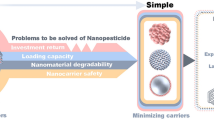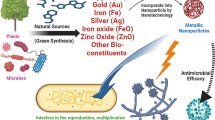Abstract
Copper (II) oxide nanoparticles (CuO-NPs) have been studied as potential antimicrobial agents, similar to silver or platinum nanoparticles. However, the use of excess NPs is limited by their safety and toxicity in beneficial microflora and human cells. In this study, we evaluated the cytotoxicity of CuO-NPs by coating with a novel cyclic peptide, CuO binding peptide 1 (CuBP1), cyclic-SCATPFSPQVCS, which binds to the surface of CuO-NPs. CuBP1 was identified using biopanning of a T7 phage display system and was found to promote the aggregation of CuO-NPs under mild conditions. The treated CuO-NPs with CuBP1 caused the reduction of the cytotoxicity against Escherichia coli, Lactobacillus helveticus, and five other microorganisms, including bacteria and eukaryotes. Similar effects were also demonstrated against human embryonic kidney (HEK293) cells in vitro. Our findings suggested that the CuO-NPs coated with a surface-binding peptide may have applications as a safe antimicrobial agent without excessive cytotoxic activity against beneficial microflora and human cells. Moreover, a similar tendency may be achieved with other metal particles, such as silver or platinum NPs, by using optimal metal binding peptides.







Similar content being viewed by others
References
Gawande, M. B., Goswami, A., Felpin, F.-X., Asefa, T., Huang, X., Silva, R., Zou, X., Zboril, R., & Varma, R. S. (2016). Cu and Cu-based nanoparticles: synthesis and applications in catalysis. Chemical Reviews, 116(6), 3722–3811.
Zhang, D.-W., Yi, T.-H., & Chen, C.-H. (2005). Cu nanoparticles derived from CuO electrodes in lithium cells. Nanotechnology, 16(10), 2338–2341.
Zhang, J., Wang, J., Fu, Y., Zhang, B., & Xie, Z. (2015). Sonochemistry-synthesized CuO nanoparticles as an anode interfacial material for efficient and stable polymer solar cells. RSC Advances, 5(36), 28786–28793.
Manimaran, R., Palaniradja, K., Alagumurthi, N., Sendhilnathan, S., & Hussain, J. (2013). Preparation and characterization of copper oxide nanofluid for heat transfer applications. Applied Nanoscience, 4, 163–167.
Tamilvanan, A., Balamurugan, K., Ponappa, K., & Kumar, B. M. (2014). Copper nanoparticles: synthetic strategies, properties and multifunctional application. International Journal of Nanoscience, 13, 1–17.
Grigore, M., Biscu, E., Holban, A., Gestal, M., & Grumezescu, A. (2016). Methods of synthesis, properties and biomedical applications of CuO nanoparticles. Pharmaceuticals, 9(4), 75.
Li, Y., Hong, M., Lin, Y., Bin, Q., Lin, Z., Cai, Z., & Chen, G. (2012). Highly sensitive electrochemical immunoassay for H1N1 influenza virus based on copper-mediated amplification. Chemical Communications, 48(52), 6562–6564.
Das, D., Nath, B. C., Phukon, P., & Dolui, S. K. (2013). Synthesis and evaluation of antioxidant and antibacterial behavior of CuO nanoparticles. Colloids and Surfaces, B: Biointerfaces, 101, 430–433.
Sikora, P., Augustyniak, A., Cendrowski, K., Nawrotek, P., & Mijowska, E. (2018). Antimicrobial activity of Al2O3, CuO, Fe3O4, and ZnO nanoparticles in scope of their further application in cement-based building materials. Nanomaterials, 8(4), 212.
Ahamed, M., Alhadlaq, H. A., Khan, M. A. M., Karuppiah, P., & Al-Dhabi, N. A. (2014). Synthesis, characterization, and antimicrobial activity of copper oxide nanoparticles. Journal of Nanomaterials, 2014. https://doi.org/10.1155/2014/637858
Wang, Y., Yang, F., Zhang, H. X., Zi, X. Y., Pan, X. H., Chen, F., Luo, W. D., Li, J. X., Zhu, H. Y., & Hu, Y. P. (2013). Cuprous oxide nanoparticles inhibit the growth and metastasis of melanoma by targeting mitochondria. Cell Death & Disease, 4(8), e783.
Vinardell, M., & Mitjans, M. (2015). Antitumor activities of metal oxide nanoparticles. Nanomaterials, 5(2), 1004–1021.
Pant, A. B., Siddiqui, M. A., Alhadlaq, H. A., Ahmad, J., Al-Khedhairy, A. A., Musarrat, J., & Ahamed, M. (2013). Copper oxide nanoparticles induced mitochondria mediated apoptosis in human hepatocarcinoma cells. PLoS One, 8, e69534.
Shafagh, M., Rahmani, F., & Delirezh, N. (2015). CuO nanoparticles induce cytotoxicity and apoptosis in human K562 cancer cell line via mitochondrial pathway through reactive oxygen species and P53. Iranian Journal of Basic Medical Sciences, 18, 993–1000.
Chang, Y.-N., Zhang, M., Xia, L., Zhang, J., & Xing, G. (2012). The toxic effects and mechanisms of CuO and ZnO nanoparticles. Materials, 5(12), 2850–2871.
Fahmy, B., & Cormier, S. A. (2009). Copper oxide nanoparticles induce oxidative stress and cytotoxicity in airway epithelial cells. Toxicology In Vitro, 23(7), 1365–1371.
Kumari, P., Panda, P. K., Jha, E., Kumari, K., Nisha, K., Mallick, M. A., & Verma, S. K. (2017). Mechanistic insight to ROS and apoptosis regulated cytotoxicity inferred by green synthesized CuO nanoparticles from Calotropis gigantea to embryonic zebrafish. Scientific Reports, 7(1), 16284.
Kumaran, R. S., Choi, Y. K., Kim, H. J., & Kim, K. J. (2014). Quantitation of oxidative stress gene expression in MCF-7 human cell lines treated with water-dispersible CuO nanoparticles. Applied Biochemistry and Biotechnology, 173(3), 731–740.
Ahamed, M., Akhtar, M. J., Fareed, M., & Kumar, S. (2012). Protective effect of sulphoraphane against oxidative stress mediated toxicity induced by CuO nanoparticles in mouse embryonic fibroblasts BALB 3T3. The Journal of Toxicological Sciences, 37, 139–148.
Karlsson, H. L., Cronholm, P., Gustafsson, J., & Möller, L. (2008). Copper oxide nanoparticles are highly toxic: a comparison between metal oxide nanoparticles and carbon nanotubes. Chemical Research in Toxicology, 21(9), 1726–1732.
Wang, Z., Li, N., Zhao, J., White, J. C., Qu, P., & Xing, B. (2012). CuO nanoparticle interaction with human epithelial cells: cellular uptake, location, export, and genotoxicity. Chemical Research in Toxicology, 25(7), 1512–1521.
Barbasz, A., Oćwieja, M., & Barbasz, J. (2015). Cytotoxic activity of highly purified silver nanoparticles sol against cells of human immune system. Applied Biochemistry and Biotechnology, 176(3), 817–834.
Meena, R., Kajal, K., & Paulraj, R. (2015). Cytotoxic and genotoxic effects of titanium dioxide nanoparticles in testicular cells of male Wistar rat. Applied Biochemistry and Biotechnology, 175(2), 825–840.
Xia, D.-L., Wang, Y.-F., Bao, N., He, H., Li, X.-D., Chen, Y.-P., & Gu, H.-Y. (2014). Influence of reducing agents on biosafety and biocompatibility of gold nanoparticles. Applied Biochemistry and Biotechnology, 174(7), 2458–2470.
Meena, R., Rani, M., Pal, R., & Rajamani, P. (2012). Nano-TiO2-induced apoptosis by oxidative stress-mediated DNA damage and activation of p53 in human embryonic kidney cells. Applied Biochemistry and Biotechnology, 167(4), 791–808.
Sooklert, K., Chattong, S., Manotham, K., Boonwong, C., Klaharn, I. Y., Jindatip, D., & Sereemaspun, A. (2016). Cytoprotective effect of glutaraldehyde erythropoietin on HEK293 kidney cells after silver nanoparticle exposure. International Journal of Nanomedicine, 11, 597–605.
Chen, C. L., & Rosi, N. L. (2010). Peptide-based methods for the preparation of nanostructured inorganic materials. Angewandte Chemie, International Edition, 49(11), 1924–1942.
Seker, U. O., & Demir, H. V. (2011). Material binding peptides for nanotechnology. Molecules, 16(2), 1426–1451.
Sarikaya, M., Tamerler, C., Jn, A. K.-Y., Schulten, K., & Baneyx, F. (2003). Molecular biomimetics: nanotechnology through biology. Nature Materials, 2(9), 577–585.
Walsh, T. R., & Knecht, M. R. (2017). Biointerface structural effects on the properties and applications of bioinspired peptide-based nanomaterials. Chemical Reviews, 117(20), 12641–12704.
Wang, W., Anderson, C. F., Wang, Z., Wu, W., Cui, H., & Liu, C.-J. (2017). Peptide-templated noble metal catalysts: syntheses and applications. Chemical Science, 8(5), 3310–3324.
Hatanaka, T., Matsugami, A., Nonaka, T., Takagi, H., Hayashi, F., Tani, T., & Ishida, N. (2017). Rationally designed mineralization for selective recovery of the rare earth elements. Nature Communications, 8(1), 15670.
Hatanaka, T., Ohashi, M., & Ishida, N. (2018). Ordered silica mineralization by regulating local reaction conditions. Biomaterials Science, 6(9), 2316–2319.
Zhang, Y., Zheng, F., Yang, T., Zhou, W., Liu, Y., Man, N., Zhang, L., Jin, N., Dou, Q., Zhang, Y., Li, Z., & Wen, L. P. (2012). Tuning the autophagy-inducing activity of lanthanide-based nanocrystals through specific surface-coating peptides. Nature Materials, 11(9), 817–826.
Thai, C. K., Dai, H., Sastry, M. S. R., Sarikaya, M., Schwartz, D. T., & Baneyx, F. (2004). Identification and characterization of Cu2O- and ZnO-binding polypeptide by Escherichia coli cell surface display: toward an understanding of metal oxide binding. Biotechnology and Bioengineering, 87(2), 129–137.
Carlos, F., Barbas, I. I. I., Burton, D. R., Scott, J. K., & Silverman, G. J. (2001). Phage display: a laboratory manual. Cold Spring Harbor Laboratory Press, A1, 1–A1.2.
Hatanaka, T., Ohzono, S., Park, M., Sakamoto, K., Tsukamoto, S., Sugita, R., Ishitobi, H., Mori, T., Ito, O., Sorajo, K., Sugimura, K., Ham, S., & Ito, Y. (2012). Human IgA-binding peptides selected from random peptide libraries: affinity maturation and application in IgA purification. The Journal of Biological Chemistry, 287(51), 43126–43136.
Seker, U. O. S., Wilson, B., Dincer, S., Kim, I. W., Oren, E. E., Evans, J. S., Tamerler, C., & Sarikaya, M. (2007). Adsorption behavior of linear and cyclic genetically engineered platinum binding peptides. Langmuir, 23(15), 7895–7900.
Azam, A., Ahmed, A. S., Oves, M., Khan, M. and Memic, A. (2012) Size-dependent antimicrobial properties of CuO nanoparticles against gram-positive and -negative bacterial strains. International Journal of Nanomedicine, 7, 3527–3535.
Heinz, H., & Ramezani-Dakhel, H. (2016). Simulations of inorganic-bioorganic interfaces to discover new materials: Insights, comparisons to experiment, challenges, and opportunities. Chemical Society Reviews, 45(2), 412–448.
Bao, S., Lu, Q., Fang, T., Dai, H., Zhang, C., & Brakhage, A. A. (2015). Assessment of the toxicity of CuO nanoparticles by using Saccharomyces cerevisiae mutants with multiple genes deleted. Applied and Environmental Microbiology, 81(23), 8098–8107.
Long, Y.-M., Hu, L.-G., Yan, X.-T., Zhao, X.-C., Zhou, Q.-F., Cai, Y., & Jiang, G.-B. (2017). Surface ligand controls silver ion release of nanosilver and its antibacterial activity against Escherichia coli. International Journal of Nanomedicine, 12, 3193–3206.
Shah, P., Kaushik, A., Zhu, X., Zhang, C., & Li, C.-Z. (2014). Chip based single cell analysis for nanotoxicity assessment. Analyst, 139(9), 2088–2098.
Shah, P., Zhu, X., Chen, C., Hu, Y., & Li, C.-Z. (2014). Lab-on-chip device for single cell trapping and analysis. Biomedical Microdevices, 16(1), 35–41.
Acknowledgements
We gratefully acknowledge Mayu Kubota and Ritsuko Kitagawa at Toyota CRDL for technical assistance with all data collection. We would like to thank Editage for English language editing. This research did not receive any specific grant from funding agencies in the public, commercial, or not-for-profit sectors.
Author information
Authors and Affiliations
Corresponding author
Ethics declarations
Conflict of Interest
The authors declare that they have no conflict of interest.
Additional information
Publisher’s Note
Springer Nature remains neutral with regard to jurisdictional claims in published maps and institutional affiliations.
Electronic supplementary material
ESM 1
(DOCX 1.44 mb)
Rights and permissions
About this article
Cite this article
Ishida, N., Hosokawa, Y., Imaeda, T. et al. Reduction of the Cytotoxicity of Copper (II) Oxide Nanoparticles by Coating with a Surface-Binding Peptide. Appl Biochem Biotechnol 190, 645–659 (2020). https://doi.org/10.1007/s12010-019-03108-9
Received:
Accepted:
Published:
Issue Date:
DOI: https://doi.org/10.1007/s12010-019-03108-9




